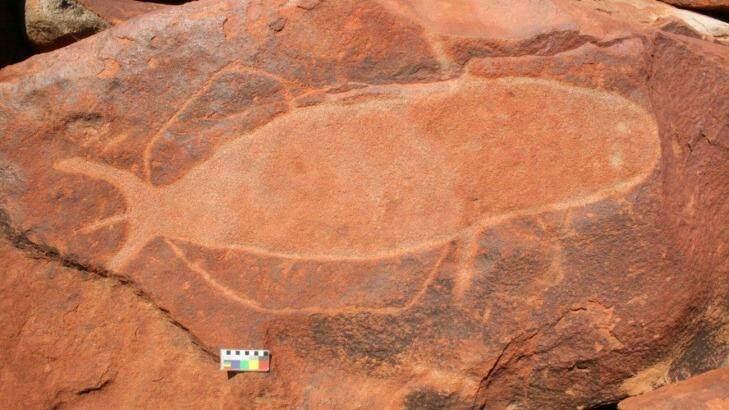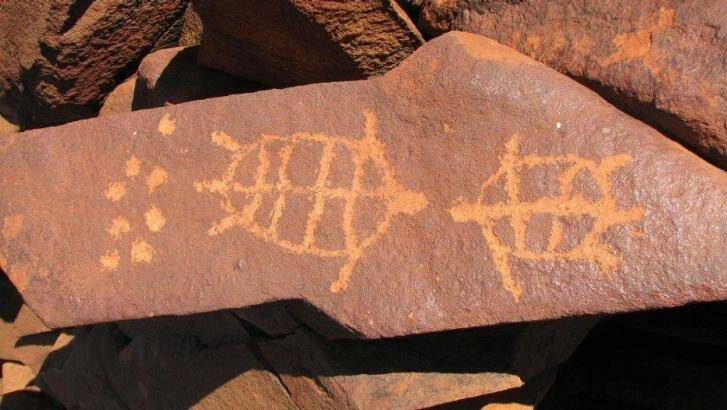




One of Australia's most significant heritage sites – the Burrup Peninsula Aboriginal rock art in the state's north west – could soon be given World Heritage status.
WA Premier Colin Barnett, who was in the Pilbara region on Monday, is calling for the Burrup Peninsula to be the first cultural site in Australia to be nominated for UNESCO World Heritage status.
"It is important this unique rock art is recognised nationally and internationally for its incredible cultural record of Aboriginal life at this location many thousands of years ago," Mr Barnett said.
"A World Heritage listing would complement the local Murujuga Aboriginal Corporation's plans for cultural tourism opportunities and infrastructure, including the creation of a Living Knowledge Centre to conserve, protect and interpret cultural values and sites on the peninsula."
The Premier said the Burrup rock art would join Shark Bay and the Ningaloo Coast to become the third World Heritage-listed place of "special cultural or physical significance on the WA coast".
The Burrup Peninsula is on the National Heritage register and is home to more than a million Aboriginal rock carvings, some dating back more than 30,000 years. The art includes the oldest known representation of a human face on Earth. The art is part of the living culture of the local Aboriginal community, which is represented by the Murujuga Aboriginal Corporation.
Campaigners for the rock art, such as the Perth-based Friends of Australian Rock art, say World Heritage listing is essential to protect it from the large industrial facilities on the peninsula.
At a Senate hearing this month, CSIRO was asked to withdraw its recommended maximum acid emission levels from local industry affecting the rock art on the Burrup Peninsula, as the science on which it was based on "isn't appropriate".
The Senate environment committee also heard from a former CSIRO deputy divisional chief that the world's largest collection of rock art "will be destroyed" by current levels of acid emissions.
Successive governments, federal and state, have failed to have the Burrup Peninsula rock art listed as a World Heritage Site, despite claims that this was their intention.
A trail of correspondence and public statements from Labor and Liberal politicians expressed commitments to list the area on UNESCO's World Heritage list.
Mr Barnett has repeatedly referred to the rock art as having "world significance". In 2006 he said it was "absolutely inevitable" that the Burrup rock art would get World Heritage listing.
In August last year he tweeted a video saying the site would become World Heritage listed at some stage.
There are some concerns World Heritage listing will be used to open the north of the Burrup to tourism, which could put further pressure on the artwork and the role of the traditional custodians.
Greens MP Robin Chapple said the Barnett government was making an election promise they might not be able to implement.
"Barnett had his opportunity to nominate in 2015 and deliberately didn't do it when invited by the Federal government to do so," he told WAtoday.
"Queensland and Victoria did.
"It is unfortunate that he has waited this long to do so, given I first nominated the place in 2003 and was met with overwhelming opposition from both sides of politics.
"Mr Barnett was given an opportunity to nominate it again just 12 months ago; that he is doing so now just smacks of political opportunism."
Former Greens leader Christine Milne has been campaigning for World Heritage listing on behalf of the Bob Brown Foundation.
"We want UNESCO protection because it is one of the world's truly great cultural sites. However, we should be under no illusion that on its own it will fully protect the rock art," she said.
"We are concerned that opening the northern Burrup to tourism will put further pressure on the site.
"There needs to be full consultation with the local Aboriginal community."
Ms Milne said that without reducing industry on the Burrup, the rock art will continue to be threatened with destruction.
"It is essential that industrial development is scaled down.
"Yara's ammonium nitrate plant should be moved to the Maitland industrial estate."
Back in 2009, Mr Barnett was labelled a "hypocrite" by the Greens after he said ancient Aboriginal rock art and industry could co-exist on the Burrup Peninsula.
At the time the Premier released the final reports from the Burrup Rock Art Monitoring Management Committee, a body set up in 2002 to study whether industrial emissions were affecting the 30,000-year-old rock engravings.
The reports found there were low concentrations of various air pollutants, with a "moderate increase" in concentrations at sites close to industrial developments.
Mr Barnett said the reports showed that the rock art was not being affected by industrial emissions.
"The conclusion of four years of exhaustive studies... shows that this rock art can co-exist with industry," he said.
However, the author of the original report on which those findings were based on said that the CSIRO was "just plain wrong" to use his findings to set acid load recommendations on the Burrup.
Last week Woodside said it wanted to use its "Burrup hub" to handle undeveloped offshore gas fields, which would further increase industry on the peninsula.
This year, Yara Pilbara and Orica Australia expect to start production at its $700 million ammonium nitrate facility, which is less than a kilometre from the nearest rock art petroglyphs.
According to Yara Pilbara's environmental compliance assessment reports, the plant will annually produce 135 tonnes of nitrogen oxides, 164 tonnes of nitrous oxide, 41 tonnes of carbon dioxide, 18 tonnes of methane, 20 tonnes of ammonia and 25.2 tonnes of dust-sized ammonium nitrate particles. Many of these emissions would increase acid load onto the surrounding rock art.
On a previous trip to the region a few years ago, Mr Barnett described the art work as "Australia's most significant heritage site" and that it was "embarrassing" that it was not being preserved.
WA Labor leader Mark McGowan said: "If elected, we will be in a position to see what work, if any, has been done on progressing the work of the previous Labor Government [on protecting the Burrup]. WA Labor will then be in a position to assess what further steps need to be taken."

